2. 中国科学院地球化学研究所, 矿床地球化学国家重点实验室, 贵阳 550081;
3. 湖南城市学院土木工程学院, 益阳 413000;
4. 湖南科技大学资源环境与安全工程学院, 湘潭 410201
2. State Key Laboratory of Ore Deposit Geochemistry; Institute of Geochemistry, Chinese Academy of Sciences, Guiyang 550081, China;
3. College of Civil Engineering, Hunan City University, Yiyang 413000, China;
4. School of Resource & Environment and Safety Engineering, Hunan University of Science and Technology, Xiangtan 410201, China
赋存于变质地体中的金矿床,约占世界岩金储量的60%,是世界上最重要的金矿类型(Groves et al., 1998, 2003; Goldfarb et al., 2005)。产于浅变质岩中金矿床的成因,一直是国际矿床学界的研究热点和难点(Groves et al., 2003; Goldfarb et al., 2005)。这些金矿在成因上究竟是造山型金矿,还是侵入岩有关的金矿?很难进行有效判别。因为许多浅变质地体中这两类金矿的地质、地球化学特征存在诸多相同或相似之处(Goldfarb et al., 2000, 2005; Hart et al., 2002; Groves et al., 2003; Hart, 2005, 2007;Hart and Goldfarb, 2005),而金矿形成的时间也难以准确测定,致使这类变质地体中很多金矿的成因被弄混淆(Hart and Goldfarb, 2005)。
湘中是全球最重要的锑金矿成矿省,该区前寒武纪浅变质岩中赋存了大量的金矿床(图 1),但这些金矿的形成时代和成因类型一直存在争议(罗献林, 1989, 1991;钟东球,1990;黎盛斯,1991;梁华英,1991;史明魁等,1993;李恒新,1995;李伟等,2016;彭建堂等,2017)。近年来在该区一些金(锑)矿中新发现了不同规模的钨矿体或钨矿化(李惠纯等,2016;裴科等,2017;彭建堂,2019),这为人们利用白钨矿来解决该区变质岩中金矿的成矿时代和矿床成因提供了可能。
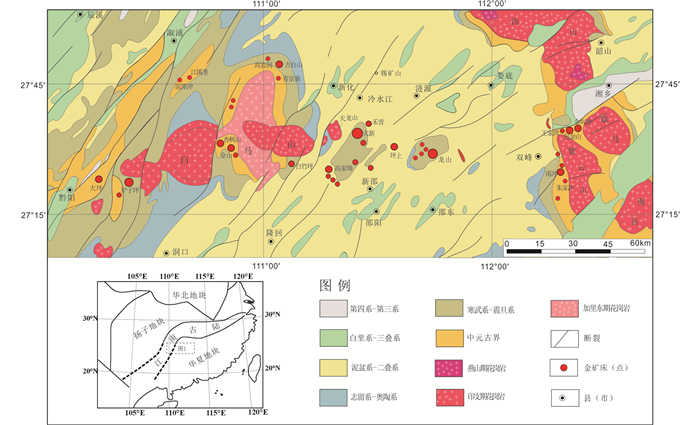
|
图 1 湘中白马山-龙山-紫云山金矿带金矿分布(地质图据湖南省地质矿产局, 2002①修改;金矿床(点)据康如华,2002、孙际茂等,2007) Fig. 1 Distribution map of gold deposits in the Baimashan-Longshan-Ziyunshan gold mineralization belt, central Hunan (gold deposits adopted from Kang, 2002; Sun et al., 2007) |
① 湖南省地质矿产局.2002. 1/150万湖南省地质图
包金山金矿床位于湘中白马山-龙山-紫云山金矿带的东段(图 1),紫云山岩体北缘的外接触带(图 2)。因为发现较晚,该矿的研究程度较低,前人仅对其流体包裹体(鞠培姣等,2016)和矿区出露的长英质脉岩(鲁玉龙等,2017a)进行过研究,该矿的准确形成时间和矿床成因,目前尚不清楚。最近在该矿区发现有钨矿化,前人也对其地质特征进行了简单的报道(裴科等,2017),但该区白钨矿的矿物学特征、元素地球化学和同位素地球化学特征,尚不清楚。在野外调研和室内镜下研究的基础上,本文对该区白钨矿的地质特征进行归纳总结,利用X射线衍射(XRD)、电子探针(EMPA)、电感耦合等离子质谱(ICP-MS)、同位素稀释法-质谱分析(ID-MS)等多种测试手段,对该区白钨矿开展了主量元素、微量元素(含稀土元素)、Sm-Nd同位素和Sr同位素地球化学研究,精确确定了该矿的形成时间,探讨了其成矿物质来源,并结合区域上最新的年代学资料,进一步讨论了湘中地区印支期的成矿作用,揭示了湘中一带金矿床的成因,以期推动华南印支期成矿作用的深入研究。

|
图 2 湘中紫云山地区花岗岩及矿床(点)分布图(据毛卫红等,2000①修改) Fig. 2 Geological map of the Ziyunshan pluton and gold deposits, central Hunan |
① 毛卫红, 李凤辉, 曹爱军. 2000. 湖南省双峰县包金山金矿勘探地质报告. 湖南有色二总队地质报告
1 矿床地质特征包金山矿区出露的地层为新元古界板溪群的马底驿组(图 3)。该地层为一套浅变质的泥质、粉砂质碎屑岩,大体可分为三个岩性段:第一段为变质砂岩段(Pt3bnm1),其基本被紫云山岩体侵蚀殆尽;第二段为钙质板岩段(Pt3bnm2),其岩性主要为深灰色条带状板岩、斑点板岩,以及粉砂质和砂质板岩,常夹有灰岩透镜体或钙质条带,厚度1300m;第三段为砂质板岩段(Pt3bnm3),岩性为深灰色绢云母板岩、砂质和粉砂质板岩等,厚度530m。包金山矿区的矿体均赋存于板溪群的钙质板岩段(Pt3bnm2)(图 3)。
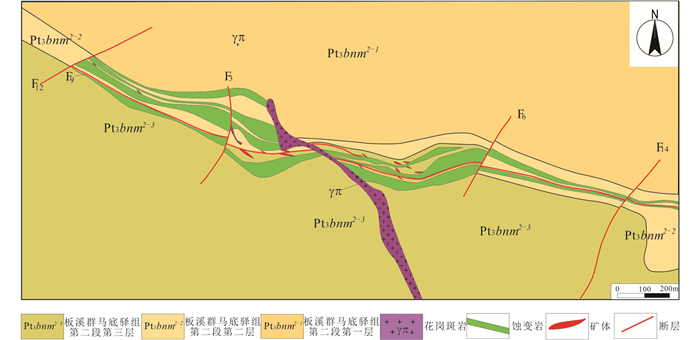
|
图 3 包金山金钨矿床的矿区地质简图(据毛卫红等,2000修改) Fig. 3 The sketch geological map of the Baojinshan gold deposit, central Hunan |
矿区褶皱构造不发育,总体上为一向北倾斜的单斜构造,地层倾角为20°~30°。该区断裂构造发育,主要有近EW向、NE向、近SN向和NW向4组断裂。其中,近EW向断裂是紫云山环状拆离断层的一部分,主要由近平行的断裂F9和F7组成,倾向北,倾角为46°~77°,均表现出张剪性的特征,整体上表现为右旋的剪切构造体系,控制着金坑冲-包金山-王家湾整个矿带的空间展布(毛卫红等,2000)。在两者之间发育NW向和NEE向两组次级断裂,前者为向南倾的张性断裂,为主容矿构造;后者为向北倾的剪性断裂,断裂较紧闭,局部容矿,它们联合控制着矿体的产出。
矿区出露的岩浆岩主要为长英质脉岩,地表受风化影响多呈灰白色,坑道中颜色稍深。这些脉岩走向为NW向,倾向NE,断续出露,且穿插矿体,在其上、下盘常存在厚且富的金矿体。坑道中亦可见脉岩被石英脉错断的现象,但这些脉岩又明显受到后期热液作用的影响:坑道中采集的标本颜色明显偏绿(绿泥石化),斑晶轮廓较模糊;镜下可见长石斑晶发生了绢云母化和绿泥石化、石英斑晶被溶蚀成浑圆状或半浑圆状(鲁玉龙等,2017a)。
在包金山矿区,矿体主要赋存于板溪群马底驿组第二段的钙质板岩中,严格受近EW向断裂构造带的控制(图 3)。矿区存在破碎带蚀变岩型和石英脉型两类金矿,但以石英脉型为主,目前该矿累计探明金的储量达5吨以上,达到中型金矿的规模(毛卫红等,2000)。石英脉型金矿主要有脉状和筒状两类矿体。其中脉状矿体,石英脉多呈雁形排列,走向NW,倾向SW,倾角为45°~67°;矿体沿走向方向延伸较短,一般为20m左右,倾向延深相对较大,矿体厚度为0.2~2.0m(毛卫红等,2000)。筒状矿体的走向和倾向,与脉状矿体大致相近,但规模相对较大,厚度达数米到十多米,倾向延深可达100m。金矿化主要分布于石英脉与围岩的接触部位,靠近围岩的石英脉中常见明金,但金品位变化较大。破碎带蚀变岩型金矿主要发育于F9断层破碎带及其上、下盘的层间破碎带中,呈脉状、似层状产出。
矿石矿物成分比较简单,除自然金外,还有磁黄铁矿、白钨矿以及少量黄铁矿和黄铜矿,局部地段可见辉锑矿;脉石矿物主要为石英和方解石,另有少量铁白云石、绢云母和绿泥石。矿石构造以浸染状构造为主,次有块状构造、脉状构造和条带状构造。矿石结构以充填交代结构、它形粒状结构和压碎结构为主,次有溶蚀结构、包含结构、自形-半自形粒状结构等。脉型金矿的围岩蚀变主要为褪色化、硅化、磁黄铁矿化和黄铁矿化,而破碎蚀变岩型金矿则主要为硅化、黄铁矿化、磁黄铁矿化、绢云化和绿泥石化(鞠培姣等,2016)。
包金山矿区的白钨矿均分布于含金石英脉中,白钨矿主要呈团块状、斑点状产出(图 4a, b),少量呈细脉状(图 4b)。该区白钨矿主要以矿物集合体的形式产出,仅少量白钨矿颗粒的晶面可见明显的油脂光泽;其颜色以米黄色、浅黄色为主(图 4a-d),部分呈肉红色,荧光灯下该区白钨矿普遍为天蓝色(图 4e, f)。少数致密块状白钨矿中,肉眼可见晚期细脉穿插于其中。
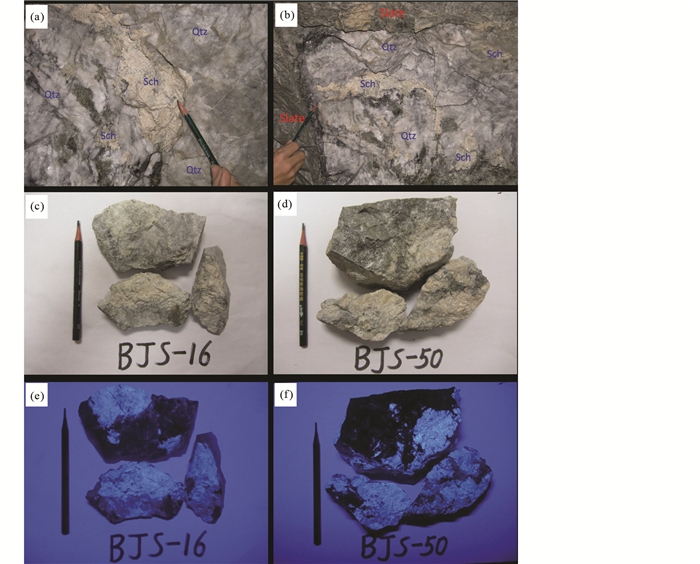
|
图 4 包金山矿区白钨矿的野外露头和手标本照片 Sch-白钨矿; Qtz-石英; slate-板岩 Fig. 4 The photographs of outcrop of tungsten mineralization in the Baojinshan ore district and its handspecimen Sch-scheelite; Qtz-quartz |
本次研究所使用的白钨矿样品,均采自包金山矿区井下坑道的含金石英脉,其采样位置及样品特征见表 1。选取代表性样品磨制薄片和光薄片,供镜下岩相学研究、X射线衍射分析(XRD)和电子探针成分分析(EMPA);在此基础上,挑选代表性样品并将其碎至40~60目,利用重选方法将白钨矿初步富集,然后借助紫外荧光灯,在双目镜下将杂质剔除,使白钨矿的纯度达到99%以上,最后将纯净的白钨矿颗粒碎至200目,以供微量元素和同位素分析之用。
|
|
表 1 白钨矿样品的采样位置及基本特征 Table 1 Sampling locations and important features of tungsten ores in this study |
本次研究的白钨矿样品,其晶胞参数测定和主量元素分析在中南大学地球科学与信息物理学院完成,使用的仪器分别为日本理学D500型X射线全自动衍射仪和日本岛津EMPA-1720H型电子探针分析仪;微量元素的测定采用ICP-MS方法,在中国科学院地球化学研究所矿床地球化学国家重点实验室完成,使用的仪器为美国PE公司的ELAN DRC-e型Q-ICP-MS质谱仪,分析精度优于5%。
样品的Sm-Nd同位素和Sr同位素分析在中国地质调查局天津地质调查中心完成,使用的仪器为美国赛默飞世尔公司的TRITON 08-100016sb型热电离质谱仪(TIMS),Sm、Nd含量测定采用同位素稀释法,Nd和Sr同位素比值是对提纯的样品直接进行测定。采用HF+HClO4法溶样,Nd的纯化采用HDEHP反色层法,以确保没有144Sm对144Nd的干扰。详细的化学前处理方法参见彭建堂等(2003a)。
3 白钨矿的矿物学和地球化学特征 3.1 白钨矿的矿物学特征在显微镜下,该区白钨矿为无色,具有正极高突起,正交镜下干涉色为一级紫红,白钨矿与石英的接触界面通常较平整(图 5a),但亦可见白钨矿边部发生碎裂并被石英包裹的现象(图 5a),局部亦可见石英呈脉状沿白钨矿裂隙充填(图 5b)。另外,方解石与白钨矿共存现象也相当普遍(图 5c-f),白钨矿可破碎为角砾状,并被后期热液方解石胶结(图 5d);白钨矿中方解石脉较常见,且可见多期方解石脉体穿插于白钨矿中(图 5e, f)。
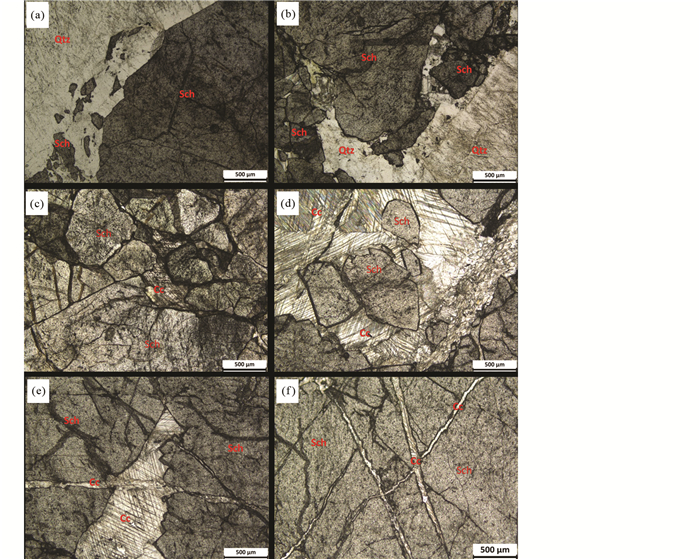
|
图 5 包金山矿区白钨矿的镜下特征 (a)白钨矿(Sch)与石英(Qtz)接触界线较为平整,局部伴有破碎现象(-);(b)局部可见石英沿白钨矿裂隙充填(-);(c)方解石(Cc)分布于白钨矿之中,中心白钨矿发生破碎并被方解石胶结(-);(d)白钨矿被方解石胶结(-);(e)方解石充填于白钨矿裂隙中,两者被更晚的方解石脉切割(-);(f)白钨矿被多期方解石细脉穿插(-) Fig. 5 Micrographs of scheelite from the Baojinshan ore district (a) scheelite (Sch) occurring in flat contact with intergrown quartz (Qtz), scheelite locally brecciated and distributed in quartz (-); (b) quartz locally filled by scheelite; (c) calcite (Cc) occurring in scheelite, scheelite in the core brecciated and cemented by calcite (-); (d) scheelite cemented by calcite (-); (e) calcite filled in the fissures of scheelite, both crosscut by later calcite vein (-); (f) scheelite crosscut by multi-stage calcite veins (-) |
X射线衍射分析(XRD)表明,该区白钨矿的晶胞参数变化较小,a0为0.5236~0.5243nm,平均为0.5240nm;c0为1.1356~1.1365nm,平均为1.1363nm;c0/a0为2.167~2.170,平均为2.168(表 2)。该区白钨矿的晶胞参数a0和c0的平均值,稍小于白钨矿的理论值,但其c0/a0比值与理论值相当吻合。
|
|
表 2 包金山矿区白钨矿的晶胞参数 Table 2 The lattice parameters of scheelite from the Baojinshan ore district |
包金山矿区白钨矿的化学成分较稳定,其WO3为80.26%~80.91%,平均为80.57%;CaO为18.19%~18.61%,平均为18.48%(表 3)。与其理论值(WO3:80.53%,CaO:19.47%,王濮等,1987)比较,本次测定白钨矿的WO3值大体与其理论值一致,但CaO含量稍低于其理论值。
|
|
表 3 包金山矿区白钨矿的电子探针分析数据(wt%) Table 3 The EMPA data of scheelite collected from the Baojinshan ore district (wt%) |
根据本次所测的电子探针数据,运用电价平衡原理,我们计算得到包金山矿区白钨矿的化学式为Ca0.97W1.02O4.02,很明显,该区白钨矿中的Ca2+亏损,这可能与白钨矿中Sr、REE、Y、Na等元素与Ca发生类质同象置换有关,后文的微量元素分析数据也证实了这一点。
统计表明,那些与石英共存的白钨矿,其矿物颗粒边部WO3含量为79.43%~81.80%(平均为80.45%,N=30)、CaO含量为17.83%~18.80%(平均为18.42%,N=30),颗粒内部(核部)WO3含量为79.44%~81.77%(平均为80.46%,N=39)、CaO含量为17.86%~18.94%(平均为18.47%,N=39),白钨矿颗粒的核部与边部化学成分基本一致。但那些与方解石共存的白钨矿颗粒,其边部WO3含量为80.08%~82.78%(平均为81.00%,N=27)、CaO含量为18.18%~18.87%(平均为18.55%,N=27),均明显高于那些与石英共生的白钨矿。其原因目前尚不清楚,有待进一步探讨。
3.3 白钨矿的微量元素组成包金山矿区白钨矿的微量元素分析结果见表 4。该区白钨矿中Sr含量很高,为1221×10-6~1438 ×10-6,平均为1329×10-6,但其它微量元素普遍偏低。除Sr以外,只有Li、Cr、Ni、Ga、As和Ba等6种元素含量大于1×10-6。与地壳中的元素平均丰度(Rudnick and Gao, 2003)比较,该区白钨矿的这些微量元素,只有Sr的含量远高于地壳中的平均值,As的含量是克拉克值的1.2~2倍,少量样品的Mo含量接近或超过其克拉克值,而其它元素含量均远低于其克拉克值。
|
|
表 4 包金山金矿中白钨矿微量元素含量(×10-6) Table 4 The trace element concentrations of scheelite samples collected from the Baojinshan ore district (×10-6) |
人们通常认为,Mo、Bi、Sn、Nb、Ta等元素与W在离子半径、离子电位或电负性等化学性质上近似,因此它们可在白钨矿中以类质同象置换的方式得到一定程度的富集,尤其是Mo在白钨矿中更为富集(刘英俊和马东升,1987)。但包金山矿区白钨矿中这些元素含量均低于1×10-6,明显不同于与华南燕山期花岗岩有关的白钨矿(刘英俊和马东升,1987;Ding et al., 2018; Wu et al., 2019),而与西澳Kalgoorlie、Norsman-Cambalda等地区太古代绿岩带型金矿和云南大坪金矿中的白钨矿微量元素特征相似(Sylvester and Ghaderi, 1997; Brugger et al., 2000;熊德信等,2006)。包金山矿区白钨矿贫Mo,很可能与该区成矿流体偏还原性有关。因为自然界中Mo可以以+4价和+6价两种价态存在,其中Mo6+可以呈完全类质同象替换白钨矿中的W6+,而Mo4+则很难进入白钨矿晶格中,故氧化条件下形成的白钨矿富Mo,而还原条件形成的白钨矿往往贫Mo(Hsu, 1977)。
3.4 白钨矿的稀土元素组成包金山矿区白钨矿的稀土元素分析结果见表 5,其球粒陨石标准化稀土元素配分模式如图 6所示。
|
|
表 5 包金山矿区白钨矿的稀土元素组成(×10-6)及其特征参数 Table 5 REE concentrations and its characteristic parameters of scheelite samples collected from the Baojinshan ore district (×10-6) |
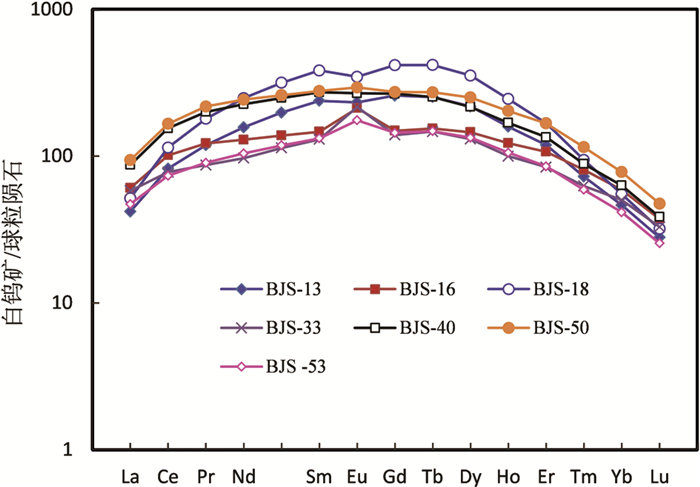
|
图 6 包金山矿区白钨矿的球粒陨石标准化稀土元素配分模式图(标准化值据Taylor and McLennan, 1985) Fig. 6 Chondrite-normalized REE patterns for the scheelite samples collected from the Baojinshan ore district (normalization values after Taylor and McLennan, 1985) |
由表 5可知,该区白钨矿稀土元素含量较高,其∑REE+Y为484.5×10-6~972.9×10-6,平均为721.3×10-6,显著高于湘西、湘中一带金锑钨矿床中的白钨矿。已有的研究表明,湘西沃溪矿区中白钨矿的∑REE+Y为40.5×10-6~123.6 ×10-6(彭建堂等,2005),渣滓溪矿区为11.13×10-6~136.9 ×10-6(彭建堂等,2010),西安钨矿区为19.3×10-6~120×10-6(作者未刊数据);湘中杏枫山矿区的白钨矿为3.03×10-6~374.5×10-6(作者未刊数据),龙山谢家山矿区为43.5×10-6~104×10-6(Zhang et al., 2019)。目前尚不清楚,为什么包金山白钨矿的稀土元素含量显著高于邻近其它矿区中的白钨矿。
该区不同白钨矿样品的稀土元素配分模式均相当吻合,均为向上拱曲的MREE富集型(图 6),与湘西沃溪矿区(彭建堂等,2005)和西安矿区(作者未刊资料)的白钨矿类似。这种富MREE的白钨矿,在我国云南大坪金矿(熊德信等,2006)以及西澳太古代绿岩带型金矿(Sylvester and Ghaderi, 1997; Brugger et al., 2000)中均有发现。这种向上拱曲的REE配分模式,也常被视为热液成因白钨矿的典型特征(Brugger et al., 2000;彭建堂等,2005)。
由于REE3+与白钨矿中Ca2+的离子半径相似,故易替代晶格中Ca2+,以类质同象形式进入白钨矿中。已有的研究表明,这种向上拱曲富MREE的稀土元素配分模式,与热液体系中络合物的稳定性无关,而是与白钨矿矿物中Ca位置的大小密切相关,主要受晶体化学因素的制约(彭建堂等,2005)。MREE富集型白钨矿,其REE3+置换Ca2+进入白钨矿晶格中的方式主要受以下类质同象置换机制的制约:REE3++Na+=2Ca2+(Ghaderi et al., 1999)。由于八次配位时,Ca2+的晶格空位(1.12Å),Na+半径约为1.18Å,因此,置换Ca2+的REE3+,其离子半径平均值应为1.06Å左右(与Eu3+半径相当),故离子半径最接近1.06Å的MREE最容易进入白钨矿晶格中,而离子半径偏离1.06Å较多的其它稀土元素,则相对难进入白钨矿之中。因此,包金山矿区的白钨矿应形成于一种富Na+的热液中,这种热液环境中有利于MREE3+与Na+以组合的方式,优先置换晶格中的Ca2+而进入白钨矿中(Ghaderi et al., 1999)。
该区白钨矿的Ce异常不明显,但Eu异常较复杂,正、负Eu异常都有,还有的几乎没有Eu异常(图 6),这一点与沃溪矿区白钨矿(彭建堂等,2005)较为类似,这种Eu异常现象可能与白钨矿形成温度较高有关。前人已有的研究表明,Ca与REE在白钨矿中均为八次配位,八次配位的Eu2+(1.25Å)和Eu3+(1.066Å)与Ca2+(1.12Å)的离子半径均相近,因此,Eu2+和Eu3+都可存在于白钨矿晶格之中;但热力学计算表明,在形成白钨矿的物理化学条件下,Eu主要是以Eu2+的形式存在(Brugger et al., 2000)。该区白钨矿形成温度较高,其流体包裹体均一温度介于267~417℃,大部分在300℃以上(裴科等,2017);在这种高温环境中,有利于Eu以Eu2+形式存在。值得注意地是,从图 6中我们可以发现,Eu异常似乎与稀土含量高低有关,稀土含量最高的样品为负异常,而稀土含量低的样品,均显示为正Eu异常。图 7也充分证实了这种趋势的确存在。白钨矿中Eu2+的存在也指示该矿形成于一种较还原的条件下,这与该区白钨矿贫Mo的特征相吻合。另外该区载金硫化物是磁黄铁矿而非黄铁矿,也指示包金山矿区确实是形成于一个温度较高、相对还原的条件下。
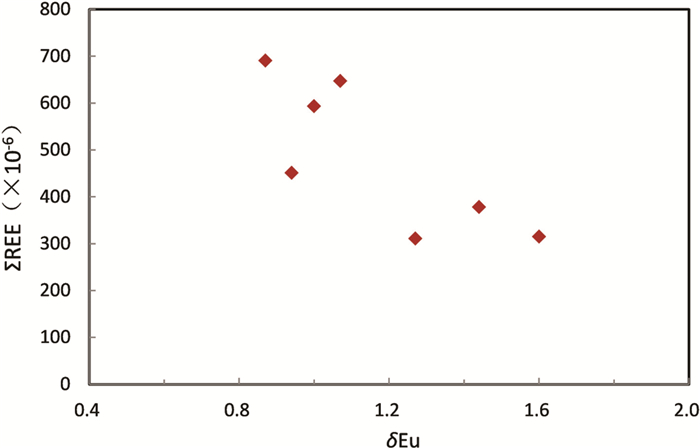
|
图 7 包金山矿区白钨矿中Eu异常与稀土元素含量的关系 Fig. 7 Plot of Eu anomaly and the total REE concentration for the scheelite samples collected from the Baojinshan ore district |
本次对包金山矿区8件白钨矿样品进行Sm-Nd同位素和Sr同位素分析,分析结果见表 6。研究表明,该区白钨矿Sm和Nd含量均较高,分别为34.78×10-6~122.7×10-6和83.95×10-6~205.4×10-6;147Sm/144Nd变化范围为0.2079~0.4070,143Nd/144Nd为0.512126~0.512398。在Sm-Nd同位素图解中,尽管本次分析的8件样品均有线性分布趋势,但只有5件样品能拟合成一条很好的直线(图 8)。在1/Nd-143Nd/144Nd图解中,所有样品点均没有线性分布趋势,故可以排除该直线为混合线的可能性。该区白钨矿构筑的等时线对应的年龄为207.8±1.5Ma(MSWD=1.03),对应的截距(143Nd/144Nd)i为0.511845±3(2σ)(图 8)。
|
|
表 6 包金山金钨矿床白钨矿的Sm、Nd含量和Sr、Nd同位素组成 Table 6 Sm and Nd concentrations, Sr and Nd isotopic compositions of scheelite samples collected from the Baojinshan Au-W deposit |
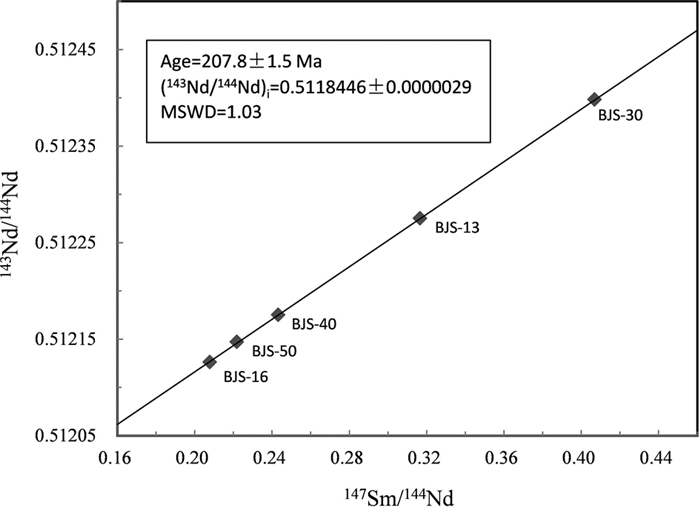
|
图 8 包金山矿区白钨矿Sm-Nd同位素等时线 Fig. 8 Sm-Nd isotopic isochron of scheelite samples collected from the Baojinshan ore district |
白钨矿(CaWO4)本身是含氧盐,其化学性质稳定,不易受后期热液的影响;且已有的实验证实,稀土元素在白钨矿中扩散速度很慢,白钨矿形成以后其Sm-Nd同位素体系易保持封闭状态(张东亮,2009)。因此,我们可以排除后期热液事件对3件离散的白钨矿样品(BJS-13、BJS-33和BJS-53)的影响。白钨矿样品BJS-16、BJS-18和BJS-50均可见后期方解石穿插早期白钨矿的现象,但这些样品均能拟合到本次的Sm-Nd等时线(图 8)上,也充分证实了这一点。我们推测这3件离散的白钨矿样品,可能与其形成时成矿流体的Nd同位素组成受到附近围岩的扰动有关。众所周知,在通常情况下成矿流体中的REE含量较低(Michard and Albarède, 1986; Michard, 1989; Douville et al., 1999),流体中的Nd同位素组成很容易受到外界的影响,如有一些围岩中的Nd混入,热液体系中的Nd同位素组成在局部就会发生明显改变,从而可能导致整个成矿体系中Nd同位素的不均一性。这种不均一性往往会造成热液矿床中不同脉体或同一脉体中的不同矿物的143Nd/144Nd值有较大波动(Halliday et al., 1990;彭建堂等,2008),甚至同一手标本中相同矿物的不同部位或不同颜色部分的Nd同位素值都可能存在差异(Menuge and Feely, 1997;彭建堂等,2003b)。在热液矿床中这种Nd的混合作用往往会导致无法得到有效的Sm-Nd等时线(彭建堂等,2008)或得到两条斜率大体一致但(143Nd/144Nd)i明显不同的等时线(彭建堂等,2003b;Su et al., 2009)。
本次得到的包金山矿区白钨矿的Sm-Nd等时线年龄(207.8±1.5Ma),稍晚于该矿区长英质脉岩(223~225Ma,鲁玉龙等,2017a)和区域上紫云山岩体的成岩年龄(220~225Ma,Chu et al., 2012; 刘凯等,2014;鲁玉龙等,2017b);但与前人获得的区域上的大坪金矿(204.8±6.3Ma,李华芹等,2008)、铲子坪金矿(205.6±9.4Ma,李华芹等,2008)和谢家山金锑钨矿(210±2Ma,Zhang et al., 2019)的成矿年龄相当吻合。
正如前所述,该区白钨矿样品中Sr含量很高(表 4),其Sr同位素组成也较大,其87Sr/86Sr比值为0.73164~0.73974(表 6)。该区白钨矿的Sr同位素组成,大体与渣滓溪矿区白钨矿(0.73036~0.73294,彭建堂等,2008)相当,高于廖家坪矿区(0.72127~0.72146,Peng and Frei, 2004)和龙山矿区的白钨矿(0.7209~0.7228,Zhang et al., 2019),但明显低于沃溪矿区(0.74675~0.75003,彭建堂等,2003c;彭渤等,2006)和西安矿区(0.75412~0.78231,作者未刊资料),这显示该区不同时代形成的金矿床或钨矿床,其成矿物质来源或其成矿流体流经的路径可能存在着差异性。
白钨矿系含钙矿物,其晶格中Ca的位置能有限地容纳Sr而不接受Rb,故其Rb含量低,Rb/Sr值很小,矿物形成后由Rb原地衰变产生的放射成因87Sr对锶同位素组成的影响甚小(彭建堂等,2003c)。且在热液体系中矿物发生沉淀时,Sr同位素不会发生明显分馏,因此,白钨矿的87Sr/86Sr测定值可代表矿物沉淀时成矿流体的初始Sr同位素组成。包金山矿区,白钨矿中Rb含量均小于0.4×10-6,而其Sr含量则均在1200×10-6以上(表 4),其Rb/Sr比值几乎接近于0,因此,表 6中这些白钨矿的Sr同位素测定值,完全能代表其成矿流体的Sr同位素组成。包金山矿区白钨矿的87Sr/86Sr值为0.73164~0.73974,表明该区形成白钨矿的成矿流体是一种相当富放射成因87Sr的热液。
为了更进一步制约该区成矿物质的来源,我们将包金山白钨矿的Sr-Nd同位素组成与紫云山岩体进行对比(图 9),发现该区白钨矿的投影点远离紫云山主体花岗岩,但与其补体花岗岩较近,部分样品点与补体花岗岩重叠,这表明包金山矿区的成矿作用,可能与紫云山岩体的晚期岩浆活动有关。
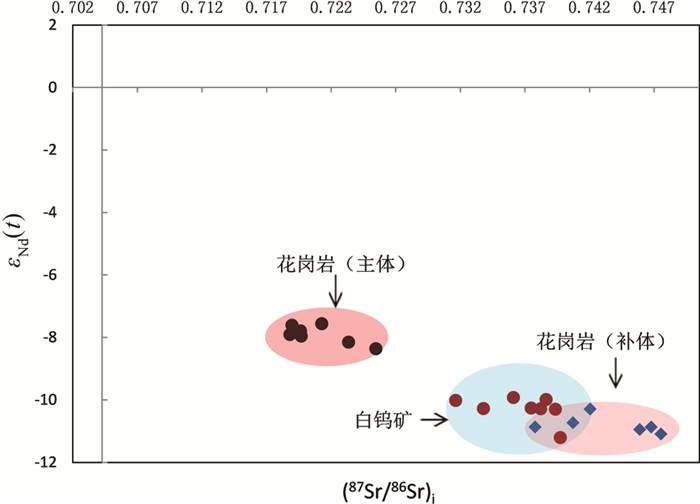
|
图 9 包金山矿区白钨矿和紫云山岩体的Sr-Nd同位素组成图解 花岗岩的Sr、Nd同位素组成据鲁玉龙(2018) Fig. 9 Plot of Sr-Nd isotopes for the scheelite samples in Baojinshan and the Ziyunshan pluton Sr and Nd isotope data for the Ziyunshan pluton from Lu (2018) |
湖南95%以上的金矿分布于前寒武纪浅变质地层中,主要分布于湘西雪峰山地区和湘中白马山-龙山-紫云山一带(罗献林, 1989, 1991;黎盛斯,1991;鲍振襄,1994;孙际茂等,2007;彭建堂等,2017)。相对于湘西雪峰山一带金矿而言,湘中一带金矿床发现较晚,研究程度也普遍偏低。关于湘中金矿床的形成时代,前人研究不多。根据矿石铅同位素的模式年龄,罗献林(1989)认为包金山附近的金坑冲金矿为印支-燕山期产物,而钟东球(1990)则认为该矿形成于燕山早期。史明魁等(1993)利用石英流体包裹体Rb-Sr同位素测年技术,得到该区龙山金锑矿的形成时间为175±27Ma。李华芹等(2008)采用相同方法,得到该区铲子坪和大坪金矿的成矿年龄分别为205.6±9.4Ma和204.8±6.3Ma。最近付山岭等(2016)和Zhang et al. (2019)分别对该区龙山金锑矿床和谢家山金锑钨床进行了年代学研究。
由表 7可知,尽管湘中地区不同金矿床,其矿化类型、成矿元素组合和赋矿层位可能存在差异,但其形成时间均集中在195~225Ma之间,为印支期成矿,对应于晚三叠世。这明显不同于湘西雪峰山一带的金矿床,后者主要形成于380~410Ma之间(彭建堂等,2003a),为晚加里东期成矿。
|
|
表 7 湘中白马山-龙山-紫云山金矿床的形成时间 Table 7 The mineralization timing of gold deposits in the Baimashan-Longshan-Ziyunshan ore belt, central Hunan |
最近对湘中盆地周缘前寒武系浅变质岩中的一些钨矿床研究也显示,该区印支期钨成矿也非常重要,如渣滓溪矿区细脉型钨矿形成于227.3±6.2Ma(王永磊等,2012)、大溶溪矽卡岩型钨矿形成于223.3±3.9Ma(张龙升等,2014)、最近新发现的木瓜园斑岩型钨矿形成于225.4±1.4Ma(陕亮等,2019)。最新研究发现,产于湘中盆地泥盆系沉积岩之中的曹家坝矽卡岩型钨矿,也是印支期形成的(196~206Ma,Xie et al., 2019)。因此,印支期的成矿作用在湘中地区非常普遍,值得我们今后高度重视。
5 湘中金矿床的成因变质地体中的金矿床分为造山型金矿、与侵入岩有关的金矿和非典型金矿(Groves et al., 2003; Goldfarb et al., 2005),其中造山型金矿和与侵入岩有关的金矿最为重要。正如前所言,浅变质中金矿的矿床成因,一直是国际矿床学界的研究热点和难点,因为在很多浅变质地体中,这两类金矿床在成矿元素组合(Au-Bi-Sb-W)、围岩蚀变、成矿流体性质、构造控矿、与岩浆岩空间关系等方面存在很大的相似性(Sillitoe and Thompson, 1998; Groves et al., 2003; Goldfarb et al., 2005; Hart, 2005, 2007; Hart and Goldfarb, 2005)。因此,精确的成矿年代学研究对浅变质地体中这两类金矿的判别是至关重要的,因为它能准确判断成矿作用与区域变形变质作用和岩浆作用的关系。
已有的研究表明,包括江南古陆、武夷地区、云开地区在内的广大华南地区,其区域性的变形、变质作用主要发生于早古生代(贾宝华,1994;侯光久等,1998;丘元禧等,1999;舒良树等,1999;Wang et al., 2007, 2013; Faure et al., 2009; Li et al., 2010; Shu et al., 2014),华南地区大规模的区域变形、变质是加里东构造运动的产物,其时限大约为360~440Ma(侯光久等,1998;舒良树等, 1999, 2008;Li et al., 2010;胡召齐等,2010;胡艳华等,2011)。本次获得的包金山金矿的形成时间为207.8±1.5Ma,整个湘中地区金矿的形成时间为204~224Ma,在时间上比华南区域性的加里东期变形变质作用至少要晚130Myr,因此,该区产于浅变质岩中的金矿床不可能是造山型金矿。
尽管都是产于前寒武系浅变质岩中,湘中一带的金矿床却表现出明显不同于湘西雪峰山一带造山型金矿床的地质特征(彭建堂等,2017),而是显示出与岩浆作用关系密切。如:在空间分布上,湘中金矿大多围绕花岗岩岩体(如白马山、紫云山等)分布或产于隐伏岩体(大乘山、龙山等)之上(图 1);湘中地区金矿类型多样,以破碎蚀变岩型(龙山、大新、包金山)为主,亦存在少量石英脉型(古台山、杏枫山)金矿,还有产于沉积岩中的高家坳、白云铺等微细浸染型金矿,符合与侵入岩有关的金系统(Intrusion-related gold system, IRGS)金矿化多样性的特点(Thompson et al., 1999; Lang et al., 2000; Lang and Baker, 2001; Hart, 2007);湘中金矿床中硫化物一般含量较少,且主要为毒砂和磁黄铁矿,杏枫山等矿区发现较多热液成因钛铁矿,表现出还原性成矿特征,这与IRGS型金矿中硫化物少、还原性矿物组合特征相吻合(Thompson et al., 1999; Lang et al., 2000; Lang and Baker, 2001; Hart, 2005, 2007);湘中地区部分金矿的近矿围岩显示出高温热液蚀变特征,如在杏枫山矿区,围岩蚀变主要为黑云母化、毒砂化、石榴子石化和钛铁矿化,而包金山则主要为磁黄铁矿化。另外,在成矿温度方面,湘中金矿的形成温度较高,比雪峰山一带造山型金矿至少要高50~100℃(彭建堂等,2017;肖静芸等,2020),且湘中一带金矿(如龙山、包金山、铲子坪、古台山、杏枫山等)的成矿流体盐度,变化范围均较宽(0.1%~15% NaCleqv;梁华英,1991;曹亮等,2015;鞠培姣等,2016;李伟等,2016;肖静芸等,2020),完全不同于造山型金矿低盐度的特征(< 6.0% NaCleqv;Groves et al., 1998, 2003; Ridley and Diamond, 2000; Goldfarb et al., 2005)。因此,湘中产于前寒武系浅变质岩中的金矿床,其地质特征明显不同于造山型金矿,应属与侵入岩有关的金矿类型(IRGS型)。且我们的研究表明,湘中白马山、紫云山、大神山等印支期花岗岩,还原性特征明显,属钛铁矿型花岗岩(徐接标,2017;王川等,2021)。因此,湘中一带的金矿床应是与还原性侵入岩有关的矿床(IRGS)。
值得注意地是,最新的研究表明,湘中地区印支期岩浆活动的范围和强度,远超出过去的传统认识。过去一些被认为是加里东期形成的花岗岩,如桃江岩体、紫云山主体,均形成于印支期(Wang et al., 2012;Xu et al., 2014a;刘凯等,2014;鲁玉龙等,2017b);过去被视为燕山期形成的白马山岩体龙藏湾单元,实为印支期岩浆活动的产物(刘建清等,2013;Qiu et al., 2014; Fu et al., 2015;徐接标,2017);那些传统上被认为是燕山期的长英质脉岩,如板溪矿区的石英斑岩、龙山矿区外围的花岗斑岩、花岗闪长斑岩,紫云山外围包金山矿区的花岗闪长斑岩,也均是印支期形成的(赵军红等,2005;陈佑纬等,2016;鲁玉龙等,2017a)。近年来,随着越来越多高精度年代学数据的积累(王岳军等,2005;陈卫锋等,2007;罗志高等,2010;Chu et al., 2012; 张龙升等,2012;刘建清等,2013;Qiu et al., 2014;Xu et al., 2014b; 李建华等,2014;Fu et al., 2015; 柏道远等,2016;鲁玉龙等,2017b;徐接标,2017;王川等,2021),人们趋于意识到,湘中地区的岩浆活动90%发生于晚三叠世,晚古生代岩浆活动较弱,晚中生代的岩浆活动更弱,至今未发现该区存在小于180Ma的花岗质岩浆活动。但该区印支期花岗岩的成矿潜力如何,目前尚不是太清楚,有待于进一步深入研究。
6 结论(1) 包金山矿区白钨矿的化学成分较均一,其WO3含量大体与理论值一致,但CaO含量稍低于其理论值。
(2) 除Sr、REE和As以外,该区白钨矿的微量元素均小于其克拉克值,明显有别于华南与燕山期花岗岩有关钨矿床中的白钨矿。
(3) 该区白钨矿的稀土元素含量高,显著高于湘西、湘中一带其它金、钨矿床中的白钨矿,其稀土元素配分模式均为向上拱曲的MREE富集型。
(4) 包金山矿区白钨矿Sm-Nd同位素等时线年龄为207.8±1.5Ma,对应于晚三叠世;湘中地区印支期的金、钨成矿作用广泛存在,且与印支期花岗质岩浆活动密切相关。
(5) 湘中金矿床是与还原性侵入岩有关的金矿床(IRGS)。
致谢 野外工作得到湖南有色二总队谭辉跃、石坚、周溪等工程师的大力支持和帮助;样品测试过程中得到中国科学院地球化学研究所漆亮研究员、中南大学谷湘平教授和刘建平副教授、以及中国地调局天津地质调查中心刘文刚博士的大力支持;审稿专家提出了宝贵的修改意见;在此一并致以诚挚的谢意!
Bai DY, Wu NJ, Zhong X, Jia PY, Xiong X and Huang WY. 2016. Geochronology, petrogenesis and tectonic setting of Indosinian Wawutang granites, southwestern Hunan Province. Geotectonica et Metallogenia, 40(5): 1075-1091 (in Chinese with English abstract)
|
Bao ZX. 1994. Geological characteristics of the Baimashan-Longshan-Lilin Sb-Au metallogenic belt in central Hunan. Gold Science and Technology, 2(4): 29-35 (in Chinese)
|
Brugger J, Lahaye Y, Costa S, Lambert D and Bateman R. 2000. Inhomogeneous distribution of REE in scheelite and dynamics of Archaean hydrothermal systems (Mt. Charlotte and Drysdale gold deposits, Western Australia). Contributions to Mineralogy and Petrology, 139(3): 251-264 DOI:10.1007/s004100000135
|
Cao L, Duan QF, Peng SG and Zhou Y. 2015. Characteristics of fluid inclusions in the Chanziping gold deposit in western Hunan Province and their geological implications. Geology and Exploration, 51(2): 212-224 (in Chinese with English abstract)
|
Chen WF, Chen PR, Huang HY, Ding X and Sun T. 2007. Chronological and geochemical studies of granite and enclave in Baimashan pluton, Hunan, South China. Science in China (Series D), 37(7): 873-893 (in Chinese)
|
Chen YW, Bi XW, Fu SL and Dong SH. 2016. Zircon U-Pb dating and Hf isotope of the felsic dykes in the Longshan Au-Sb deposit in central Hunan Province and their geological significance. Acta Petrologica Sinica, 32(11): 3469-2488 (in Chinese with English abstract)
|
Chu Y, Faure M, Lin W and Wang QC. 2012. Early Mesozoic tectonics of the South China Block: Insights from the Xuefengshan intracontinental orogen. Journal of Asian Earth Sciences, 61(Suppl.1): 199-220
|
Ding T, Ma DS, Lu JJ and Zhang RQ. 2018. Garnet and scheelite as indicators of multi-stage tungsten mineralization in the Huangshaping deposit, southern Hunan Province, China. Ore Geology Reviews, 94: 193-211 DOI:10.1016/j.oregeorev.2018.01.029
|
Douville E, Bienvenu P, Charlou JL, Donval JP, Fouquet Y, Appriou P and Gamo T. 1999. Yttrium and rare earth elements in fluids from various deep-sea hydrothermal systems. Geochimica et Cosmochimica Acta, 63(5): 627-643 DOI:10.1016/S0016-7037(99)00024-1
|
Faure M, Shu LS, Wang B, Charvet J, Choulet F and Monie P. 2009. Intracontinental subduction: A possible mechanism for the Early Palaeozoic orogen of SE China. Terra Nova, 21(5): 360-368 DOI:10.1111/j.1365-3121.2009.00888.x
|
Fu SL, Hu RZ, Bi XW, Chen YW, Yang JH and Huang Y. 2015. Origin of Triassic granites in central Hunan Province, South China: constraints from zircon U-Pb ages and Hf and O isotopes. International Geology Review, 57(2): 97-111 DOI:10.1080/00206814.2014.996258
|
Fu SL, Hu RZ, Chen YW and Luo JC. 2016. Chronology of the Longshan Au-Sb deposit in central Hunan Province: Constraints from pyrite Re-Os and Zircon U-Th/He isotopic dating. Acta Petrologica Sinica, 32(11): 3507-3517 (in Chinese with English abstract)
|
Ghaderi M, Palin JM, Campbell IH and Sylvester PJ. 1999. Rare earth element systematics in scheelite from hydrothermal gold deposits in the Kalgoorlie-Norseman region, Western Australia. Economic Geology, 94(3): 423-437 DOI:10.2113/gsecongeo.94.3.423
|
Goldfarb RJ, Hart C, Miller M, Miller L, Farmer GL and Groves D. 2000. The Tintina Gold Belt: A global perspective. British Columbia and Yukon Chamber of Mines, Special Volume 2: 5-34
|
Goldfarb RJ, Barker T, Dubé B, Groves DI, Hart CJR and Gosslein P. 2005. Distribution, character, and genesis of gold deposits in metamorphic terranes. Economic Geology, 100th Anniversary Volume, 407-450
|
Groves DI, Goldfarb RJ, Gebre-Mariam M, Hagemann SG and Robert F. 1998. Orogenic gold deposits: A proposed classification in the context of their crustal distribution and relationship to other gold deposit types. Ore Geology Reviews, 13(1-5): 7-27 DOI:10.1016/S0169-1368(97)00012-7
|
Groves DI, Goldfarb RJ, Robert F and Hart CJR. 2003. Gold deposits in metamorphic belts: Overview of current understanding, outstanding problems, future research, and exploration significance. Economic Geology, 98(1): 1-29
|
Halliday AN, Shepherd TJ, Dickin AP and Chesley JT. 1990. Sm-Nd evidence for the age and origin of a Mississippi Valley Type ore deposit. Nature, 344(6261): 54-56 DOI:10.1038/344054a0
|
Hart CJR, McCoy DT, Goldfarb RJ, Smith M, Roberts P, Hulstein R, Bakke AA and Bundtzen TK. 2002. Geology, exploration and discovery in the Tintina gold province, Alaska and Yukon. In: Goldfarb RJ and Nielsen RL (eds. ). Integrated Methods for Discovery: Global Exploration in the Twenty-First Century. Society of Economic Geologists, 9: 241-274
|
Hart CJR. 2005. Classifying, distinguishing and exploring for intrusion-related gold systems. The Gangue, (87): 1-18
|
Hart CJR and Goldfarb RJ. 2005. Distinguishing intrusion-related from orogenic gold systems. In: New Zealand Minerals Conference, 125-133
|
Hart CJR. 2007. Reduced intrusion-related gold systems. In: Goodfellow WD (ed. ). Mineral Deposits of Canada: A Synthesis of Major Deposit Types, District Metallogeny, the Evolution of Geological Provinces, and Exploration Methods. Geological Association of Canada, Mineral Deposits Division, 95-112
|
Hou GJ, Suo ST, Zheng GZ and Wei QR. 1998. Caledonian orogensis and system: Transition in the Xuefengshan area. Hunan Geology, 17(3): 141-144 (in Chinese with English abstract)
|
Hsu LC. 1977. Effects of oxygen and sulfur fugacities on the scheelite-tungstenite and powellite-molybdenite stability relations. Economic Geology, 72(4): 664-670 DOI:10.2113/gsecongeo.72.4.664
|
Hu YH, Gu MG, Xu Y, Yu SQ, Wang JE and He Y. 2011. The confirmation of the age of Caledonian Chencai Group in Zhuji area of Zhejiang Province and its geological significance. Geological Bulletin of China, 30(11): 1661-1670 (in Chinese with English abstract)
|
Hu ZQ, Zhu G, Zhang BL and Zang L. 2010. K-Ar geochronology of the Caledonian event in the Xuefeng uplift. Geological Review, 56(4): 490-500 (in Chinese with English abstract)
|
Jia BH. 1994. Tectonic deformation of the Xuefeng uplift area in Hunan. Regional Geology of China, (1): 65-71 (in Chinese with English abstract)
|
Ju PJ, Lai JQ, Mo QY, Shi J, Tan HY and Tao SL. 2016. Ore-forming fluid characteristics and genesis of Baojinshan gold deposit in Shuangfeng County, Hunan Province, China. The Chinese Journal of Nonferrous Metals, 26(12): 2625-2639 (in Chinese with English abstract)
|
Kang RH. 2002. Analysis of exploration perspective of gold-antimony deposits in Baimashan-longshan EW-striking structural zone, Hunan Province. Geology and Mineral Resources of South China, 18(1): 57-61 (in Chinese with English abstract)
|
Lang JR, Baker T, Hart CJR and Mortensen JK. 2000. An exploration model for intrusion-related gold systems. Society of Economic Geologists Newsletter, 40(1): 6-14
|
Lang JR and Baker T. 2001. Intrusion-related gold systems: The present level of understanding. Mineralium Deposita, 36(6): 477-489 DOI:10.1007/s001260100184
|
Li HC, Wen JZ, Yin XS, Li CF, Cai LL, Chen ZX, Song CL and Cheng SX. 2016. Geological characteristics of Xiejiashan gold-antimony deposit and prospecting in the depth and surrounding areas in Hunan. Mineral Exploration, 7(5): 743-752 (in Chinese with English abstract)
|
Li HQ, Wang DH, Chen FW, Mei YP and Cai H. 2008. Study on chronology of the Chanziping and Daping gold deposits in Xuefeng Mountains, Hunan Province. Acta Geologica Sinica, 82(7): 900-905 (in Chinese with English abstract)
|
Li HX. 1995. Relations with gold and genetic types of the granites in Hunan Province. Journal of Precious Metallic Geology, 4(4): 283-293 (in Chinese with English abstract)
|
Li JH, Zhang YQ, Xu XB, Li HL, Dong SW and Li TD. 2014. SHRIMP U-Pb dating of zircons from the Baimashan Longtan super-unit and Wawutang granites in Hunan Province and its geological implication. Journal of Jilin University (Earth Science Edition), 44(1): 158-175 (in Chinese with English abstract)
|
Li SS. 1991. Introduction to Gold Deposits in Hunan Province. Changsha: Press of Central South University, 1-360 (in Chinese)
|
Li W, Xie GQ, Zhang ZY and Zhang XK. 2016. Constraint on the genesis of Gutaishan gold deposit in central Hunan Province: Evidence from fluid inclusion and C-H-O isotopes. Acta Petrologica Sinica, 32(11): 3489-3506 (in Chinese with English abstract)
|
Li W, Xie GQ, Mao JW, Zhang ZY, Fu B and Lu S. 2018. Muscovite 40Ar/39Ar and in situ sulfur isotope analyses of the slate-hosted Gutaishan Au-Sb deposit, South China: Implications for possible Late Triassic magmatic-hydrothermal mineralization. Ore Geology Reviews, 101: 839-853 DOI:10.1016/j.oregeorev.2018.08.006
|
Li ZX, Li XH, Wartho JA, Clark C, Li WX, Zhang CL and Bao CM. 2010. Magmatic and metamorphic events during the Early Paleozoic Wuyi-Yunkai orogeny, southeastern South China: New age constraints and pressure-temperature conditions. Geological Society of America Bulletin, 122(5-6): 772-793 DOI:10.1130/B30021.1
|
Liang HY. 1991. Geochemistry of ore fluids and genesis of Longshan Au-Sb deposit, west Hunan, China. Geochimica, 20(4): 342-350 (in Chinese with English abstract)
|
Liu JQ, Xie Y, Zhao Z, Lin JS, Feng WM and Huang XP. 2013. The geochronologic characteristics of Baimashan granite in western Hunan Province and its geotectonic significance. Earth Science Frontiers, 20(5): 25-35 (in Chinese with English abstract)
|
Liu K, Mao JR, Zhao XL, Ye HM and Hu Q. 2014. Geological and geochemical characteristics and genetic significance of the Ziyunshan pluton in Hunan Province. Acta Geologica Sinica, 88(2): 208-227 (in Chinese with English abstract)
|
Liu YJ and Ma DS. 1987. Geochemistry of Tungsten. Beijing: Science Press, 1-231 (in Chinese)
|
Lu YL, Peng JT, Yang JH, Li YK, Chen XJ, Zhou X and Li GL. 2017a. Zircon U-Pb ages and Hf-O isotopes of granodiorite-porphyry in Baojinshan mining area and their geological significance. The Chinese Journal of Nonferrous Metals, 27(7): 1441-1454 (in Chinese with English abstract)
|
Lu YL, Peng JT, Yang JH, Hu AX, Li YK, Tan HY and Xiao QY. 2017b. Petrogenesis of the Ziyunshan pluton in central Hunan, South China: Constraints from zircon U-Pb dating, element geochemistry and Hf-O isotopes. Acta Petrologica Sinica, 33(6): 1705-1728 (in Chinese with English abstract)
|
Lu YL. 2018. Petrogenesis, evolution and mineralization of the Ziyunshan granite in Central Hunan Province, China. Ph. D. Dissertation. Changsha: Central South University, 1-104 (in Chinese with English summary)
|
Luo XL. 1989. On the epoch of the formation of Precambrian gold deposits in Hunan Province. Journal of Guilin College of Geology, 9(1): 25-34 (in Chinese with English abstract)
|
Luo XL. 1991. Main characteristics and genetic types of gold ore deposits in Hunan. Journal of Guilin College of Geology, 11(1): 22-33 (in Chinese with English abstract)
|
Luo ZG, Wang YJ, Luo FF, Zhang AM and Zhang YZ. 2010. LA-ICPMS zircon U-Pb dating for Baimashan and Jintan Indosinian granitic plutons and its petrogenetic implications. Geotectonica et Metallogenia, 34(2): 282-290 (in Chinese with English abstract)
|
Lv YJ, Peng JT and Cai YF. 2021. Mineralogical and geochemical characteristics and U-Pb dating of hydrothermal titanite in the Xingfengshan skarn tungsten deposit, Hunan Province. Acta Petrologica Sinica, 37(3): 830-846 (in Chinese with English abstract) DOI:10.18654/1000-0569/2021.03.12
|
Menuge JF and Feely M. 1997. Origin and granite alteration effects of hydrothermal fluid: Isotopic evidence from fluorite veins, Co. Galway, Ireland. Mineralium Deposita, 32(1): 34-43 DOI:10.1007/s001260050070
|
Michard A and Albarède F. 1986. The REE content of some hydrothermal fluids. Chemical Geology, 55(1-2): 51-60 DOI:10.1016/0009-2541(86)90127-0
|
Michard A. 1989. Rare earth element systematics in hydrothermal fluids. Geochimica et Cosmochimica Acta, 53(3): 745-750 DOI:10.1016/0016-7037(89)90017-3
|
Pei K, Lai JQ, Tao SL, Pan X and Wang ZY. 2017. Inclusion characteristics of scheelite at Baojinshan mining area in Shuangfeng County of Hunan Province. Southern Metals, (5): 10-14 (in Chinese with English abstract)
|
Peng B and Frei R. 2004. Nd-Sr-Pb isotopic constraints on metal and fluid sources in W-Sb-Au mineralization at Woxi and Liaojiaping (western Hunan, China). Mineralium Deposita, 39(3): 313-327 DOI:10.1007/s00126-004-0409-0
|
Peng B, Frei R and Tu XL. 2006. Nd-Sr-Pb isotopic geochemistry of scheelite from the Woxi W-Sb-Au deposit, Western Hunan: Implications for sources and evolution of ore-forming fluids. Acta Geologica Sinica, 80(4): 561-570 (in Chinese with English abstract)
|
Peng JT, Hu RZ, Zhao JH, Fu YZ and Lin YX. 2003a. Scheelite Sm-Nd dating and quartz Ar-Ar dating for the Woxi Au-Sb-W deposit, western Hunan. Chinese Science Bulletin, 48(18): 1976-1981 (in Chinese)
|
Peng JT, Hu RZ and Jiang GH. 2003b. Samarium-neodymium isotope system of fluorites from the Qinglong antimony deposit, Guizhou Province: Constraints on the mineralizing age and ore-forming materials' sources. Acta Petrologica Sinica, 19(4): 785-791 (in Chinese with English abstract)
|
Peng JT, Hu RZ, Zhao JH and Fu YZ. 2003c. The ore-forming fluid with a marked radiogenic 87Sr signature from the Woxi Au-Sb-W deposit and its significant implications. Bulletin of Mineralogy, Petrology and Geochemistry, 23(3): 193-196 (in Chinese with English abstract)
|
Peng JT, Hu RZ, Zhao JH, Fu YZ and Yuan SD. 2005. Rare earth element (REE) geochemistry for scheelite from the Woxi Au-Sb-W deposit, western Hunan. Geochimica, 34(2): 115-122 (in Chinese with English abstract)
|
Peng JT, Zhang DL, Hu RZ, Wu MJ and Lin YX. 2009. Sm-Nd and Sr isotopic geochemistry of hydrothermal scheelite from the Zhazixi W-Sb deposit, western Hunan. Acta Geologica Sinica, 82(11): 1514-1521 (in Chinese with English abstract)
|
Peng JT, Zhang DL, Hu RZ, Wu MJ, Liu XM, Qi L and Yu YG. 2010. Inhomogeneous distribution of rare earth elements (REEs) in scheelite from the Zhazixi W-Sb deposit, western Hunan and its geological implications. Geological Review, 56(6): 810-819 (in Chinese with English abstract)
|
Peng JT, Hu AX, Xiao JY, Guo N and Xie Q. 2017. Mineralization of two different gold deposits hosted in metamorphic terrane. In: Abstracts of the 8th National Symposium on Metallogenic Theory and Prospecting Methods. Nanchang: Editorial Department of Acta Mineralogica Sinica, 146 (in Chinese)
|
Peng JT. 2019. The first discovery of tungsten orebodies with high ore grades in the Xingfengshan gold deposit, Longhui County, Hunan Province. Geological Reviews, 65(3): 664-670 (in Chinese with English abstract)
|
Qiu L, Yan DP, Zhou MF, Arndt NT, Tang SL and Qi L. 2014. Geochronology and geochemistry of the Late Triassic Longtan pluton in South China: Termination of the crustal melting and Indosinian orogenesis. International Journal of Earth Sciences, 103(3): 649-666 DOI:10.1007/s00531-013-0996-z
|
Qiu YX, Zhang YC and Ma WP. 1999. Tectonic of the Xuefengshan and Its Evolution. Beijing: Geological Press & Sun Yat-sen University Press, 1-155 (in Chinese with English abstract)
|
Ridley JR and Diamond LW. 2000. Fluid chemistry of orogenic lode deposits and implications for genetic models. In: Hagemann SG and Brown P (eds. ). Reviews in Economic Geology. Society of Economic Geologists, 13: 141-162
|
Rudnick RL and Gao S. 2003. Composition of the continental crust. In: Holland HD and Turekian KK (eds. ). Treatise on Geochemistry. Amsterdam: Elsevier, 1-64
|
Shang L, Pang YC, Ke XZ, Liu JJ, Chen WH, Niu ZJ, Xu DM, Long WG and Wang BQ. 2019. Diagenetic and metallogenic age of the Muguayuan tungsten polymetallic deposit and its effect on regional mineralization, Taojiang County, northeastern Hunan Province, China. Geological Science and Technology Information, 38(1): 100-112 (in Chinese with English abstract)
|
Shi MK, Fu BQ, Jin XX and Zhou XC. 1993. Antimony Metallogeny in Central Part of Hunan Province. Changshan: Hunan Press of Science and Technology, 53-70 (in Chinese with English abstract)
|
Shu LS, Lu HF, Jia D, Charvet J and Faure M. 1999. Study of the 40Ar/39Ar isotopic age for the Early Paleozoic tectonothermal event in the Wuyishan region, South China. Journal of Nanjing University (Natural Sciences), 35(6): 668-674 (in Chinese with English abstract)
|
Shu LS, Yu JH, Jia D, Wang B, Shen WZ and Zhang YQ. 2008. Early Paleozoic orogenic belt in the eastern segment of South China. Geological Bulletin of China, 27(10): 1581-1593 (in Chinese with English abstract)
|
Shu LS, Jahn BM, Charvet J, Santosh M, Wang B, Xu XS and Jiang SY. 2014. Early Paleozoic depositional environment and intraplate tectono-magmatism in the Cathaysia Block (South China): Evidence from stratigraphic, structural, geochemical and geochronological investigations. American Journal of Science, 314(1): 154-186 DOI:10.2475/01.2014.05
|
Sillitoe RH and Thompson JFH. 1998. Intrusion-related vein gold deposits: Types, tectono-magmatic settings and difficulties of distinction from orogenic gold deposits. Resource Geology, 48(4): 237-250 DOI:10.1111/j.1751-3928.1998.tb00021.x
|
Su WC, Hu RZ, Xia B, Xia Y and Liu YP. 2009. Calcite Sm-Nd isochron age of the Shuiyindong Carlin-type gold deposit, Guizhou, China. Chemical Geology, 258(3-4): 269-274 DOI:10.1016/j.chemgeo.2008.10.030
|
Sun JM, Lou YL, Gao LJ and Bao ZX. 2007. Geology and metallogenesis of Precambrian gold deposits in central Hunan Province. Geology and Resources, 16(3): 189-195 (in Chinese with English abstract)
|
Sylvester PJ and Ghaderi M. 1997. Trace element analysis of scheelite by excimer laser ablation-inductively coupled plasma-mass spectrometry (ELA-ICP-MS) using a synthetic silicate glass standard. Chemical Geology, 141(1-2): 49-65 DOI:10.1016/S0009-2541(97)00057-0
|
Taylor SR and McLennan SR. 1985. The Continental Crust: Its Composition and Evolution. London: Blackwell Scientific, 1-328
|
Thompson JFH, Sillitoe RH, Baker T, Lang JR and Mortensen JK. 1999. Intrusion-related gold deposits associated with tungsten-tin provinces. Mineralium Deposita, 34(4): 323-334 DOI:10.1007/s001260050207
|
Wang C, Peng JT, Xu JB, Yang JH, Hu AX and Chen XJ. 2021. Petrogenesis and metallogenic effect of the Baimashan granitic complex in central Hunan, South China. Acta Petrologica Sinica, 37(3): 805-829 (in Chinese with English abstract) DOI:10.18654/1000-0569/2021.03.11
|
Wang D, Zheng JP, Ma Q, Griffin WL, Zhao H and Wong J. 2013. Early Paleozoic crustal anatexis in the intraplate Wuyi-Yunkai orogen, South China. Lithos, 175-176: 124-145 DOI:10.1016/j.lithos.2013.04.024
|
Wang KX, Chen PR, Chen WF, Ling HF, Zhao KD and Yu ZQ. 2012. Magma mingling and chemical diffusion in the Taojiang granitoids in the Hunan Province, China: Evidences from petrography, geochronology and geochemistry. Mineralogy and Petrology, 106(3-4): 243-264 DOI:10.1007/s00710-012-0239-1
|
Wang P, Pan ZL and Weng LB. 1987. Systematic Mineralogy: Volume 2. Beijing: Geological Publishing House (in Chinese)
|
Wang YJ, Fan WM, Liang XQ, Peng TP and Shi YR. 2005. SHRIMP zircon U-Pb dating age of the Indo-Chinese granite in Hunan and its implications. Chinese Science Bulletin, 50(12): 1259-1266 (in Chinese) DOI:10.1360/972004-603
|
Wang YJ, Fan WM, Zhao GC, Ji SC and Peng TP. 2007. Zircon U-Pb geochronology of gneissic rocks in the Yunkai massif and its implications on the Caledonian event in the South China Block. Gondwana Research, 12(4): 404-416 DOI:10.1016/j.gr.2006.10.003
|
Wang YL, Chen YC, Wang DH, Xu J and Chen ZH. 2012. Scheelite Sm-Nd dating of the Zhazixi W-Sb deposit in Hunan and its geological significance. Geology in China, 39(5): 1339-1344 (in Chinese with English abstract)
|
Wu SH, Mao JW, Ireland TR, Zhao Z, Yao FJ, Yang YP and Sun WD. 2019. Comparative geochemical study of scheelite from the Shizhuyuan and Xianglushan tungsten skarn deposits, South China: Implications for scheelite mineralization. Ore Geology Reviews, 109: 448-464 DOI:10.1016/j.oregeorev.2019.04.021
|
Xiao JY, Peng JT, Hu AX and Mu L. 2020. Characteristics of fluid inclusions of the Xingfengshan gold deposit, central Hunan, and its genetic implications. Geological Review, 66(5): 1376-1392 (in Chinese with English abstract)
|
Xie GQ, Mao JW, Bagas L, Fu B and Zhang ZY. 2019. Mineralogy and titanite geochronology of the Caojiaba W deposit, Xiangzhong metallogenic province, southern China: Implications for a distal reduced skarn W formation. Mineralium Deposita, 54(3): 459-472 DOI:10.1007/s00126-018-0816-2
|
Xiong DX, Su XM, Shi GY, Wang SW, Gao JF and Xue T. 2006. Trace elements, rare earth elements (REE) and Nd-Sr isotopic compositions in scheelites and their implications for the mineralization in Daping gold mine in Yunnan Province, China. Acta Petrologica Sinica, 22(3): 733-741 (in Chinese with English abstract)
|
Xu HJ, Ma CQ, Zhao JH and Zhang JF. 2014a. Magma mixing generated Triassic Ⅰ-type granites in South China. The Journal of Geology, 122(3): 329-351 DOI:10.1086/675667
|
Xu HJ, Ma CQ, Zhao JH and Zhang JF. 2014b. Petrogenesis of Dashenshan Ⅰ-type granodiorite: Implications for Triassic crust-mantle interaction, South China. International Geology Review, 56(3): 332-350 DOI:10.1080/00206814.2013.857457
|
Xu JB. 2017. Early Paleozoic-Mesozoic magmatism and its constraints on the mineralization in Baimashan, Hunan Province. Master Degree Thesis. Changsha: Central South University, 1-67 (in Chinese with English summary)
|
Zhang DL. 2009. Theoretical study on REE diffusion in minerals: The reliability of Sm-Nd isotope dating of scheelite. Ph. D. Dissertation. Guiyang: Institute of Geochemistry, Chinese Academy of Sciences, 1-90 (in Chinese with English abstract)
|
Zhang LS, Peng JT, Zhang DL, Hu AX and Yang JH. 2012. Geochemistry and petrogenesis of the Indosinian Dashenshan granite, western Hunan, South China. Geotectonica et Metallogenia, 36(1): 137-148 (in Chinese with English abstract)
|
Zhang LS, Peng JT, Hu AX, Lin FM and Zhang T. 2014. Re-Os dating of molybdenite from Darongxi tungsten deposit in Western Hunan and its geological implications. Mineral Deposits, 33(1): 181-189
|
Zhang ZY, Xie GQ, Mao JW, Liu WG, Olin P and Li W. 2019. Sm-Nd dating and in-situ LA-ICP-MS trace element analyses of scheelite from the Longshan Sb-Au deposit, Xiangzhong metallogenic province, South China. Minerals, 9(2): 87 DOI:10.3390/min9020087
|
Zhao JH, Peng JT, Hu RZ and Fu YZ. 2005. Chronology, petrology, geochemistry and tectonic Environment of Banxi quartz porphyry dikes, Hunan Province. Acta Geoscientica Sinica, 26(6): 525-534 (in Chinese with English abstract)
|
Zhong DQ. 1990. On the classification and distribution of gold deposits in Hunan Province. Hunan Geology, 9(4): 9-14, 22 (in Chinese with English abstract)
|
柏道远, 吴能杰, 钟响, 贾朋远, 熊雄, 黄文义. 2016. 湘西南印支期瓦屋塘岩体年代学、成因与构造环境. 大地构造与成矿学, 40(5): 1075-1091. |
鲍振襄. 1994. 湘中白马山-龙山-醴陵锑金矿带矿床地质特征、成矿作用及成因. 黄金科学技术, 2(4): 29-35. |
曹亮, 段其发, 彭三国, 周云. 2015. 雪峰山铲子坪金矿床流体包裹体特征及地质意义. 地质与勘探, 51(2): 212-224. |
陈卫锋, 陈培荣, 黄宏业, 丁兴, 孙涛. 2007. 湖南白马山岩体花岗岩及其包体的年代学和地球化学研究. 中国科学(D辑), 37(7): 873-893. |
陈佑纬, 毕献武, 付山岭, 董少花. 2016. 湘中地区龙山金锑矿床酸性岩脉U-Pb年代学和Hf同位素特征及其地质意义. 岩石学报, 32(11): 3469-3488. |
付山岭, 胡瑞忠, 陈佑纬, 骆金诚. 2016. 湘中龙山大型金锑矿床成矿时代研究: 黄铁Re-Os和锆石U-Th/He定年. 岩石学报, 32(11): 3507-3517. |
侯光久, 索书田, 郑贵州, 魏启荣. 1998. 雪峰山加里东造山运动及其体制转换. 湖南地质, 17(3): 141-144. |
胡艳华, 顾明光, 徐岩, 余盛强, 王加恩, 贺跃. 2011. 浙江诸暨地区陈蔡群加里东期变质年龄的确认及其地质意义. 地质通报, 30(11): 1661-1670. DOI:10.3969/j.issn.1671-2552.2011.11.002 |
胡召齐, 朱光, 张必龙, 张力. 2010. 雪峰隆起北部加里东事件的K-Ar年代学研究. 地质论评, 56(4): 490-500. |
贾宝华. 1994. 湖南雪峰隆起区构造变形研究. 中国区域地质, (1): 65-71. |
鞠培姣, 赖健清, 莫青云, 石坚, 谭辉跃, 陶诗龙. 2016. 湖南双峰县包金山金矿成矿流体与矿床成因. 中国有色金属学报, 26(12): 2625-2639. |
康如华. 2002. 湖南白马山-龙山东西向构造带金锑矿找矿前景分析. 华南地质与矿产, 18(1): 57-61. DOI:10.3969/j.issn.1007-3701.2002.01.010 |
黎盛斯. 1991. 湖南金矿地质概论. 长沙: 中南工业大学出版社, 1-360.
|
李恒新. 1995. 湖南省花岗岩成因类型及其与金矿的关系. 贵金属地质, 4(4): 283-293. |
李华芹, 王登红, 陈富文, 梅玉萍, 蔡红. 2008. 湖南雪峰山地区铲子坪和大坪金矿成矿作用年代学研究. 地质学报, 82(7): 900-905. DOI:10.3321/j.issn:0001-5717.2008.07.006 |
李惠纯, 文继祖, 尹显石, 李篡峰, 蔡兰兰, 陈祯祥, 宋春黎, 成晟鑫. 2016. 湖南谢家山金锑矿地质特征及边深部找矿. 矿产勘查, 7(5): 743-752. DOI:10.3969/j.issn.1674-7801.2016.05.007 |
李建华, 张岳桥, 徐先兵, 李海龙, 董树文, 李廷栋. 2014. 湖南白马山龙潭超单元、瓦屋塘花岗岩锆石SHRIMP U-Pb年龄及其地质意义. 吉林大学学报(地球科学版), 44(1): 158-175. |
李伟, 谢桂青, 张志远, 张兴康. 2016. 流体包裹体和C-H-O同位素对湘中古台山金矿床成因制约. 岩石学报, 32(11): 3489-3506. |
梁华英. 1991. 龙山金锑矿床成矿流体地球化学和矿床成因研究. 地球化学, 20(4): 342-350. DOI:10.3321/j.issn:0379-1726.1991.04.004 |
刘建清, 谢渊, 赵瞻, 林家善, 冯伟明, 黄学平. 2013. 湖南雪峰山地区白马山花岗岩年代学特征及构造意义. 地学前缘, 20(5): 25-35. |
刘凯, 毛建仁, 赵希林, 叶海敏, 胡青. 2014. 湖南紫云山岩体的地质地球化学特征及其成因意义. 地质学报, 88(2): 208-227. DOI:10.3969/j.issn.1006-0995.2014.02.011 |
刘英俊, 马东升. 1987. 钨的地球化学. 北京: 科学出版社, 1-231.
|
鲁玉龙, 彭建堂, 阳杰华, 李玉坤, 陈宪佳, 周溪, 李干龙. 2017a. 湘中包金山矿区花岗闪长斑岩的锆石U-Pb年龄、Hf-O同位素组成及其地质意义. 中国有色金属学报, 27(7): 1441-1454. |
鲁玉龙, 彭建堂, 阳杰华, 胡阿香, 李玉坤, 谭辉跃, 肖秋越. 2017b. 湘中紫云山岩体的成因: 锆石U-Pb年代学、元素地球化学及Hf-O同位素制约. 岩石学报, 33(6): 1705-1728. |
鲁玉龙. 2018. 湘中紫云山花岗岩的成因、演化及成矿作用研究. 博士学位论文. 长沙: 中南大学, 1-104
|
罗献林. 1989. 论湖南前寒武系金矿床的形成时代. 桂林冶金地质学院学报, 9(1): 25-34. |
罗献林. 1991. 湖南金矿床的成矿特征与成因类型. 桂林冶金地质学院学报, 11(1): 22-33. |
罗志高, 王岳军, 罗菲菲, 张爱梅, 张玉芝. 2010. 金滩和白马山印支期花岗岩体LA-ICPMS锆石U-Pb定年及其成岩启示. 大地构造与成矿学, 34(2): 282-290. DOI:10.3969/j.issn.1001-1552.2010.02.015 |
吕沅峻, 彭建堂, 蔡亚飞. 2021. 湖南杏枫山矽卡岩钨矿中热液榍石的矿物学、地球化学及U-Pb年代学研究. 岩石学报, 37(3): 830-846. |
裴科, 赖健清, 陶诗龙, 潘欣, 王照宇. 2017. 湖南双峰包金山矿区白钨矿流体包裹体特征. 南方金属, (5): 10-14. DOI:10.3969/j.issn.1009-9700.2017.05.004 |
彭渤, Frei R, 涂湘林. 2006. 湘西沃溪W-Sb-Au矿床白钨矿Nd-Sr-Pb同位素对成矿流体的示踪. 地质学报, 80(4): 561-570. DOI:10.3321/j.issn:0001-5717.2006.04.010 |
彭建堂, 胡瑞忠, 赵军红, 符亚洲, 林源贤. 2003a. 湘西沃溪Au-Sb-W矿床中白钨矿Sm-Nd和石英Ar-Ar定年. 科学通报, 48(18): 1976-1981. |
彭建堂, 胡瑞忠, 蒋国豪. 2003b. 萤石Sm-Nd同位素体系对晴隆锑矿成矿时代和物源的制约. 岩石学报, 19(4): 785-791. |
彭建堂, 胡瑞忠, 赵军红, 符亚洲. 2003c. 湘西沃溪Au-Sb-W矿床中富放射成因锶的成矿流体及其指示意义. 矿物岩石地球化学通报, 23(3): 193-196. |
彭建堂, 胡瑞忠, 赵军红, 符亚洲, 袁顺达. 2005. 湘西沃溪金锑钨矿床中白钨矿的稀土元素地球化学. 地球化学, 34(2): 115-122. DOI:10.3321/j.issn:0379-1726.2005.02.003 |
彭建堂, 张东亮, 胡瑞忠, 吴梦军, 林源贤. 2008. 湘西渣滓溪钨锑矿床白钨矿的Sm-Nd和Sr同位素地球化学. 地质学报, 82(11): 1514-1521. DOI:10.3321/j.issn:0001-5717.2008.11.006 |
彭建堂, 张东亮, 胡瑞忠, 吴梦君, 柳小明, 漆亮, 虞有光. 2010. 渣滓溪钨锑矿床白钨矿中稀土元素的不均匀分布及其地质意义. 地质论评, 56(6): 810-819. |
彭建堂, 胡阿香, 肖静芸, 郭宁, 谢青. 2017. 湖南变质岩地体中两类金矿的成矿作用研究. 见: 第八届全国成矿理论与找矿方法学术讨论会论文摘要文集. 南昌: 《矿物学报》编辑部, 146
|
彭建堂. 2019. 湖南杏枫山金矿区首次发现高品位的钨矿体. 地质论评, 65(3): 664-670. |
丘元禧, 张渝昌, 马文璞. 1999. 雪峰山的构造性质与演化. 北京: 地质出版社, 中山大学出版社, 1-155.
|
陕亮, 庞迎春, 柯贤忠, 刘家军, 陈文辉, 牛志军, 徐德明, 龙文国, 王滨清. 2019. 湖南省东北部地区桃江县木瓜园钨多金属矿成岩成矿时代及其对区域成矿作用的启示. 地质科技情报, 38(1): 100-112. |
史明魁, 傅必勤, 靳西祥, 周雪昌. 1993. 湘中锑矿. 长沙: 湖南科学技术出版社, 53-70.
|
舒良树, 卢华复, 贾东, 夏菲, 福赫. 1999. 华南武夷山早古生代构造事件的40Ar/39Ar同位素年龄研究. 南京大学学报(自然科学), 35(6): 668-674. |
舒良树, 于津海, 贾东, 王博, 沈渭洲, 张岳桥. 2008. 华南东段早古生代造山带研究. 地质通报, 27(10): 1581-1593. DOI:10.3969/j.issn.1671-2552.2008.10.001 |
孙际茂, 娄亚利, 高利军, 鲍振襄. 2007. 湘中前寒武系金矿地质及相关成矿问题探讨. 地质与资源, 16(3): 189-195. DOI:10.3969/j.issn.1671-1947.2007.03.005 |
王川, 彭建堂, 徐接标, 阳杰华, 胡阿香, 陈宪佳. 2021. 湘中白马山复式岩体的成因及其成矿效应. 岩石学报, 37(3): 805-829. |
王濮, 潘兆橹, 翁玲宝. 1987. 系统矿物学: 下册. 北京: 地质出版社.
|
王永磊, 陈毓川, 王登红, 徐珏, 陈郑辉. 2012. 湖南渣滓溪W-Sb矿床白钨矿Sm-Nd测年及其地质意义. 中国地质, 39(5): 1339-1344. DOI:10.3969/j.issn.1000-3657.2012.05.021 |
王岳军, 范蔚茗, 梁新权, 彭头平, 石玉若. 2005. 湖南印支期花岗岩SHRIMP锆石U-Pb年龄及其成因启示. 科学通报, 50(12): 1259-1266. DOI:10.3321/j.issn:0023-074X.2005.12.018 |
肖静芸, 彭建堂, 胡阿香, 木兰. 2020. 湘中杏枫山金矿床流体包裹体特征及其对矿床成因的指示. 地质论评, 66(5): 1376-1392. |
熊德信, 孙晓明, 石贵勇, 王生伟, 高剑锋, 薛婷. 2006. 云南大坪金矿白钨矿微量元素、稀土元素和Sr-Nd同位素组成特征及其意义. 岩石学报, 22(3): 733-741. |
徐接标. 2017. 湖南白马山早古生代-中生代岩浆活动及其对成矿的约束. 硕士学位论文. 长沙: 中南大学, 1-67
|
张东亮. 2009. 矿物中稀土元素扩散作用的理论研究: 兼论白钨矿Sm-Nd定年方法的可靠性. 博士学位论文. 贵阳: 中国科学院地球化学研究所, 1-90
|
张龙升, 彭建堂, 张东亮, 胡阿香, 阳杰华. 2012. 湘西大神山印支期花岗岩的岩石学和地球化学特征. 大地构造与成矿学, 36(1): 137-148. DOI:10.3969/j.issn.1001-1552.2012.01.017 |
张龙升, 彭建堂, 胡阿香, 林芳梅, 张婷. 2014. 湘西大溶溪钨矿床中辉钼矿Re-Os同位素定年及其地质意义. 矿床地质, 33(1): 181-189. DOI:10.3969/j.issn.0258-7106.2014.01.012 |
赵军红, 彭建堂, 胡瑞忠, 符亚洲. 2005. 湖南板溪脉岩的年代学、岩石学、地球化学及其构造环境. 地球学报, 26(6): 525-534. DOI:10.3321/j.issn:1006-3021.2005.06.007 |
钟东球. 1990. 湖南金矿床类型和分布规律. 湖南地质, 9(4): 9-14, 22. |
 2021, Vol. 37
2021, Vol. 37

